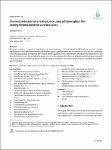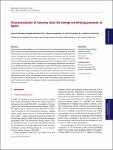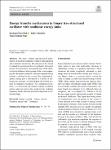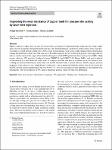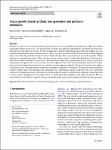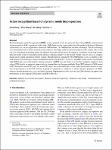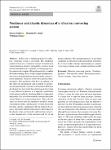Search
Author
- Amir, Ebrahimi (2)
- Aydin, Azizi (2)
- George, Haller (2)
- James, M. Fiore (2)
- next >
Subject
- robotics (9)
- Engineering (8)
- engineering (8)
- công nghệ (3)
- next >
Date issued
- 2020 - 2023 (215)
- 2010 - 2019 (28)
- 2001 - 2009 (6)
Has File(s)
- true (249)
Search Results
This paper concerns a numerical investigation of the evaporative cooling of liquid film falling along a vertical channel. The first plate is insulated and wetted by an ethylene glycol liquid film while the second one (y = d) is dry and isothermal. A marching procedure is employed for solution of the equation of mass momentum, energy and concentration in the flow. Numerical results for air-ethylene glycol system are presented. The effects of ambient gas temperature and inlet vapor mass fraction of ethylene glycol on the heat and mass transfer and on the ethylene glycol liquid film evaporation are investigated. |
Energy saving in existing buildings is of vital importance. In this work, the characterization of housing stock in Spain for energy retrofitting purposes has been performed. The regulations in force when the existing stock was constructed (1980–2007) were considered to model the envelope and thermal systems of single-family and block housing. Building energy consumption and CO2 emissions were estimated for each type of dwelling and location, ranging from 44.2 to 130.6 kWh/(m2·year) (13.6–32 kg CO2/(m2·year)) for multi-family homes, and 85.5 to 213.5 kWh/(m2·year) (17.1–45.2 kg CO2/(m2·year)) for single-family homes. A global picture of the energy performance and emissions for 13 different climate zones was obtained with a total of 504 simulations. Retrofitting of the envelope allowe... |
We study a binary tree-structured multi-degree-of-freedom nonlinear oscillator with impulsive and continuous excitations. The response of this model is studied for excitations that are applied to the largest masses. It is shown how choosing the mass of the smallest blocks influences the response of the system regarding the dissipation and how efficient targeted energy transfer is realized in the system. The simplified frequency energy plot is introduced as a means of analyzing the response of multi-degree-of-freedom systems for impulsive excitations. For continuous excitations, it is shown that the smallest masses (nonlinear energy sinks) are active only inside specific nonlinear frequency bands when the excitation amplitude is sufficiently high. |
Highly conductive copper alloys are used for various tools in casting and welding technology. In pressure die casting, copper alloys are used for pistons pressing the metal melt into a die. The high thermal conductivity of these alloys allows short process times as a result of high cooling rates. Due to a poor wear resistance, wear occurs on the running surface of the pistons causing the metal melt to spurt out of the shot sleeve. In order to improve the service life of the pistons, a new approach was taken: a reinforcement of the copper alloys with fused tungsten carbide (FTC) particles by laser melt injection (LMI) at high process velocities. FTC provides a hardness between 2700 HV 0.1 and 3500 HV 0.1. During LMI, a melt pool is induced on the substrate by a laser beam and a fille... |
The 20,000-ton combined train running has greatly promoted China’s heavy-haul railway transportation capability. The application of controllable train-tail devices could improve the braking wave of the train and braking synchronism, and alleviate longitudinal impulse. However, the characteristics of the controllable train-tail device such as exhaust area, exhaust duration and exhaust action time are not uniform in practice, and their effects on the longitudinal impulse of the train are not apparent, which is worth studying. In this work, according to the formation of the Datong–Qinhuangdao Railway, the train air brake and longitudinal dynamics simulation system (TABLDSS) is applied to establish a 20,000-ton combined train model with the controllable train-tail device, and the brakin... |
Type B aortic dissection (TBAD) carries a high risk of complications, particularly with a partially thrombosed or patent false lumen (FL). Therefore, uncovering the risk factors leading to FL thrombosis is crucial to identify high-risk patients. Although studies have shown that morphological parameters of the dissected aorta are related to FL thrombosis, often conflicting results have been reported. We show that recent models of thrombus evolution in combination with sensitivity analysis methods can provide valuable insights into how combinations of morphological parameters affect the prospect of FL thrombosis. Based on clinical data, an idealized geometry of a TBAD is generated and parameterized. After implementing the thrombus model in computational fluid dynamics simulations, a g... |
Biological tissues receive oxygen and nutrients from blood vessels by developing an indispensable supply and demand relationship with the blood vessels. We implemented a synthetic tree generation algorithm by considering the interactions between the tissues and blood vessels. We first segment major arteries using medical image data and synthetic trees are generated originating from these segmented arteries. They grow into extensive networks of small vessels to fill the supplied tissues and satisfy the metabolic demand of them. Further, the algorithm is optimized to be executed in parallel without affecting the generated tree volumes. The generated vascular trees are used to simulate blood perfusion in the tissues by performing multiscale blood flow simulations. One-dimensional blood... |
Based on dynamic mode decomposition (DMD), a new empirical feature for quasi-few-shot setting (QFSS) skeleton-based action recognition (SAR) is proposed in this study. DMD linearizes the system and extracts the modes in the form of flattened system matrix or stacked eigenvalues, named the DMD feature. The DMD feature has three advantages. The first advantage is its translational and rotational invariance with respect to the change in the localization and pose of the camera. The second one is its clear physical meaning, that is, if a skeleton trajectory was treated as the output of a nonlinear closed-loop system, then the modes of the system represent the intrinsic dynamic property of the motion. Finally, the last one is its compact length and its simple calculation without training.... |
In this work, a simulation model of a vibratory conveying system is presented. The simulation model is based on a continuous contact formulation in vertical direction which is extended by a friction force in horizontal direction to simulate a conveying process. In contrast with complex 3D simulation tools, it enables the understanding of previously unexplained phenomena such as multiple feeding velocities at the same excitation amplitude, which are observed in practical measurements. The parameters that have an influence on this effect are investigated, and a method for predicting and adjusting the occurrence of multiple solutions is developed. It is shown that the calibration of the system is very difficult in practice, as it depends significantly on the initial conditions which ar... |
In recent years, the impressive growth of new wireless technologies, together with the appearance of new requirements in applications and services, is progressively changing the use of networks. Due to the high mobility required, the network must adapt to the infrastructure to meet the demands of the users. As a result, service providers currently have to over-provision network capacity, which is costly. In addition, considering efficient resource planning in advance involves a lot of labor-intensive efforts. Consequently, network usage analysis is a very useful tool that allows network administrators to find patterns and anomalies. Whilst pattern detection provides administrators the ability to define the infrastructure, anomaly detection provides rich and valuable information for ... |

